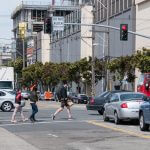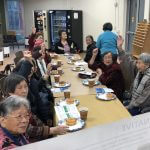Mayor Breed: The new Vision Zero Action Strategy will only succeed with your leadership
March 1, 2019
Mayor London Breed
1 Dr Carlton B Goodlett Place Room 200
San Francisco, CA 94102
Dear Mayor London Breed,
You have stood with Walk San Francisco – on the steps of City Hall and in the schoolyard of Peabody Elementary – as a Vision Zero leader. We are grateful for your leadership and commitment to eliminating all traffic fatalities and severe injuries by 2024.
Yesterday we stood at the intersection of California Street and 18th Avenue. This is where on Tuesday evening, 64-year-old Zhao Guan was hit and killed while crossing the street on the way to babysit her grandchildren. Zhao Guan is the third person to die this year while simply trying to cross the street.
We know you share our belief that this is unacceptable. Especially when we know that California Street is on the city’s high-injury network, and that we can fix these deadly streets to create safe conditions for everyone.
But changes to California Street follow the exact same pattern we have seen for safety projects across the city: they either don’t go far enough or they don’t move fast enough – or both. Unless there is leadership from the top.
We have seen what’s possible when a mayor stands up for safe streets. Because you’ve done it. Your leadership led to the passage and fast-tracking of the long overdue 6th Street and Taylor Street safety projects last year. Valencia Street and Townsend Street, desperately in need of short-term pedestrian safety fixes, got them because of you.
That’s why we’re writing you after poring over the City’s new Vision Zero Action Strategy released yesterday. The Strategy includes many of the must-have ingredients to end traffic violence. Yet making this Strategy a reality will undoubtedly require your leadership.
As such, we urge you to:
1. Ensure interagency coordination and cooperation on the biggest, most complex safety projects on the high-injury network.
This includes Market Street, the Embarcadero, and Geary. Delays are deadly and, given the City’s track record, are inevitable without your leadership.
2. Increase the pace of all projects on the high-injury network, plus get near-term safety improvements installed throughout the network by 2020.
The current list of core actions to fix our most dangerous streets in terms of design and engineering is underwhelming. Yet this is where the City can make the biggest lifesaving difference now. We need you to bring the leadership you showed on 6th, Taylor, Valencia, and Townsend to all of the high-injury network safety projects.
We also know there are many temporary, inexpensive treatments using paint and posts to increase safety; let’s be aggressive in installing quick treatments on 100% of the high-injury network by 2020.
3. Define the role of Muni in reaching Vision Zero.
We absolutely agree that significant mode shift and the City’s Transit First policy are essential for getting to Vision Zero, but there are no details in the Vision Zero Action Strategy as to how our public transportation system supports safe streets.
4. Conduct a cost assessment for Vision Zero, as well as make it easier to track SFMTA’s progress in fixing the high-injury network.
We need to understand the real needs and cost of delivering Vision Zero, particularly for SFMTA, so efforts are not held back due to insufficient staffing and funding. Meanwhile, we still don’t have a way of seeing the progress-to-date on the high-injury network.
5. Make severe injuries a Vision Zero metric.
In 2017, there were close to 575 people severely injured in traffic crashes on our streets, and this figure has not improved in the past seven years the City has been monitoring it. Ask any of the survivors in San Francisco Bay Area Families for Safe Streets how their lives have been altered by a crash, and it’s painfully clear how important it is to make this front and center in Vision Zero efforts.
We are leaning heavily on you right now, Mayor Breed. The clock is ticking on reaching Vision Zero’s goal of eliminating all traffic fatalities and severe injuries by 2024 – and we still have so far to go. But Vision Zero is possible in our great city, and your leadership will make all the difference in getting there.
We stand ready to help in every way possible, including strongly supporting the four transformative policies listed in the Vision Zero Action Strategy: automated speed enforcement; lower speed limits; regulating Uber and Lyft; and using pricing to reduce traffic on the most congested streets. There are more vehicles on our streets every day, and their impacts are all too real, from safety to climate. We have to get aggressive.
Thank you again, and we look forward to working with you to make Vision Zero a reality.
Sincerely,
Jodie Medeiros
Executive Director, Walk San Francisco
cc:
Norman Yee, President, SF Board of Supervisors
SF Board of Supervisors
SFMTA Board of Directors
Tilly Chang, Executive Director, SFCTA
Ed Reiskin, Director of Transportation, SFMTA
Mohammed Nuru, Director of San Francisco Public Works
Dr. Grant Colfax, Director of the SF Department of Public Health
John Rahaim, Director of the Planning Department
William Scott, Chief of Police, San Francisco Police Department




